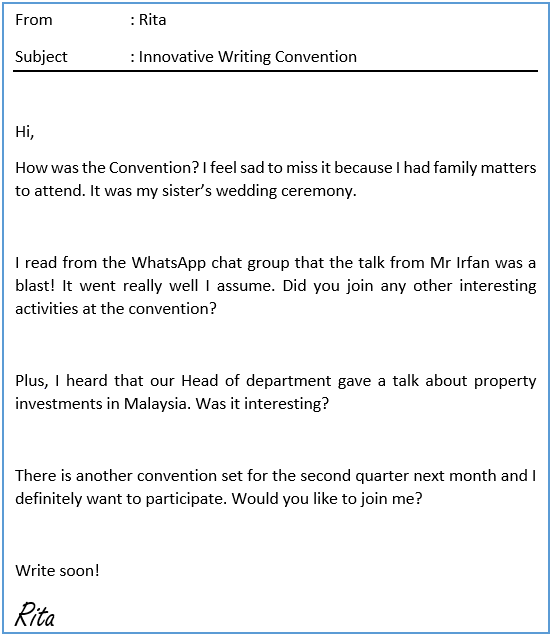Step 1: Familiarize yourself with the task.
How? Examine the email (stimulus) and pinpoint the following:
a. Recognize the keyword(s) in the question or instruction.
b. Who is the sender of the email?
c. Who is the intended recipient of the email?
d. What is the primary subject matter of the email?
Formal or casual language?
STOP RIGHT THERE! Need to know how to reply a letter for MUET question? Click https://ezuddin.com/2024/05/mastering-the-art-of-reply-why-reply-letters-matter-in-the-muet-exam/
Ok. Moving ON!!!!!!…
This is the example of the email question.
Your colleague, Rita, was absent from work because she had to attend her sister’s wedding. Read the email from her asking about the Innovative Writing Convention that she missed.

Step 2: Incorporate all the notes, keywords, and details from the email into your response.
Perhaps this will aid in clarifying the writing process.
- After identifying the notes or key ideas ,observe the possible response (refer no 1, 2, 3 & 4).
“Using all the notes given, write a reply of at least 100 words in an appropriate style.”
Based on the information above, here’s what you should consider: –
- Begin your email with a proper salutation, such as “Hi John” or “Hello buddy.”
- Start by identifying the key points or “notes” within the instructions and each paragraph. You might underline these for clarity.
- Once you’ve highlighted the notes, craft a response for each paragraph, ensuring that you address the specific points mentioned. It’s crucial to include relevant keywords from the instructions and elaborate on them in your response.
- When composing your replies, make sure to “AGREE” with any questions posed. For instance, (point no 2) if asked, “Did you join…?” your response should affirmatively state “Yes” before providing further details. Similarly, for point no 3 “Was it interesting?” respond positively and expand upon your answer.
- Given the email format, you have the flexibility to use an informal or casual language style in your responses.
STEP 3: Write the response
As always, when we are set to write the response, we should write in paragraphs. We could refer to the each of the notes above to write each of the paragraphs.
Sample responses
Note 1 (for paragraph 1)
The convention was indeed a great one! A lot of audience were there and they loved it.
Note 2 (for paragraph 2)
Yes it was interesting even though I was expecting rather new ideas from the presenter. Nonetheless, a few participants were chosen to give a highlight on the topic for a particular session and it was amazing to see the outcome. Our officemate, Mr Zooki, was in the limelight at that time. He even mentioned some quotes in British accent which to me is rather funny since he is the serious type in the office.
Note 3 (for paragraph 3)
Well, it was interesting and, actually one of the main ideas in the writing activities as well. I would say, we had different perspective about property investment though it was not part of the main purpose of this convention. But, surprisingly, his ideas on how to use other people’s money and increase your asset is worth to try for people like us.
Note 4 (for paragraph 4)
Yes, I would love to. Let me check my schedules first because I have tonnes of paperwork nearing to that occasion. I need to re-organize the workload and I will let you know as soon as possible.
So, the email would look like this.

Alright, that’s all for now. Here are some tips to keep in mind:
- When responding to inquiries about a previous event, ensure your reply includes precise details such as the venue, date, organizer, and other relevant information mentioned in the email.
- If you need to describe the event, employ appropriate adjectives and sensory details. Consider what you heard, saw, or felt during the event to enhance your description.
- Use suitable expressions to convey various purposes, such as expressing preferences, reactions, disagreements, or declining requests.
- Aim to provide detailed information by elaborating on your main points. This “advance mode” of communication can offer a more comprehensive understanding of your response.



No comments:
Post a Comment